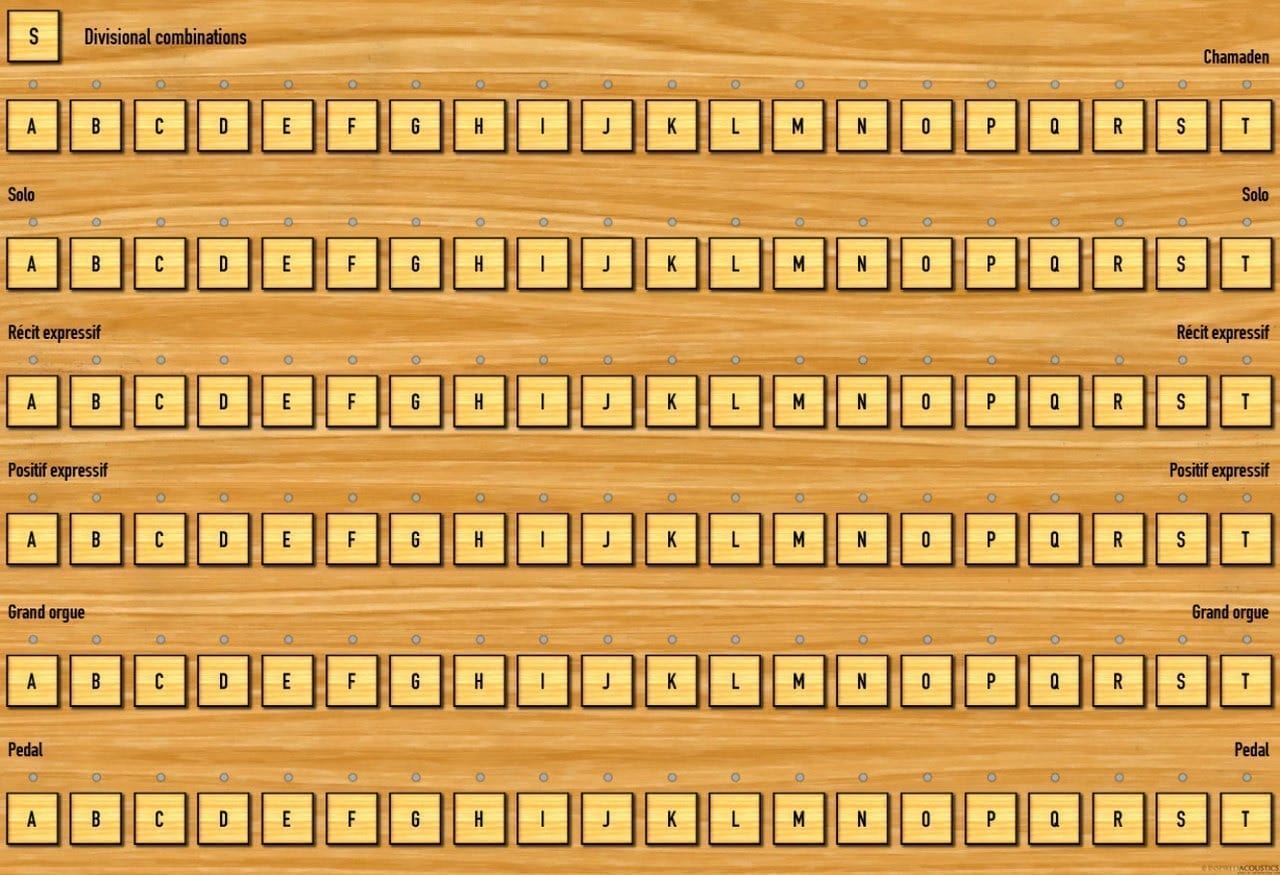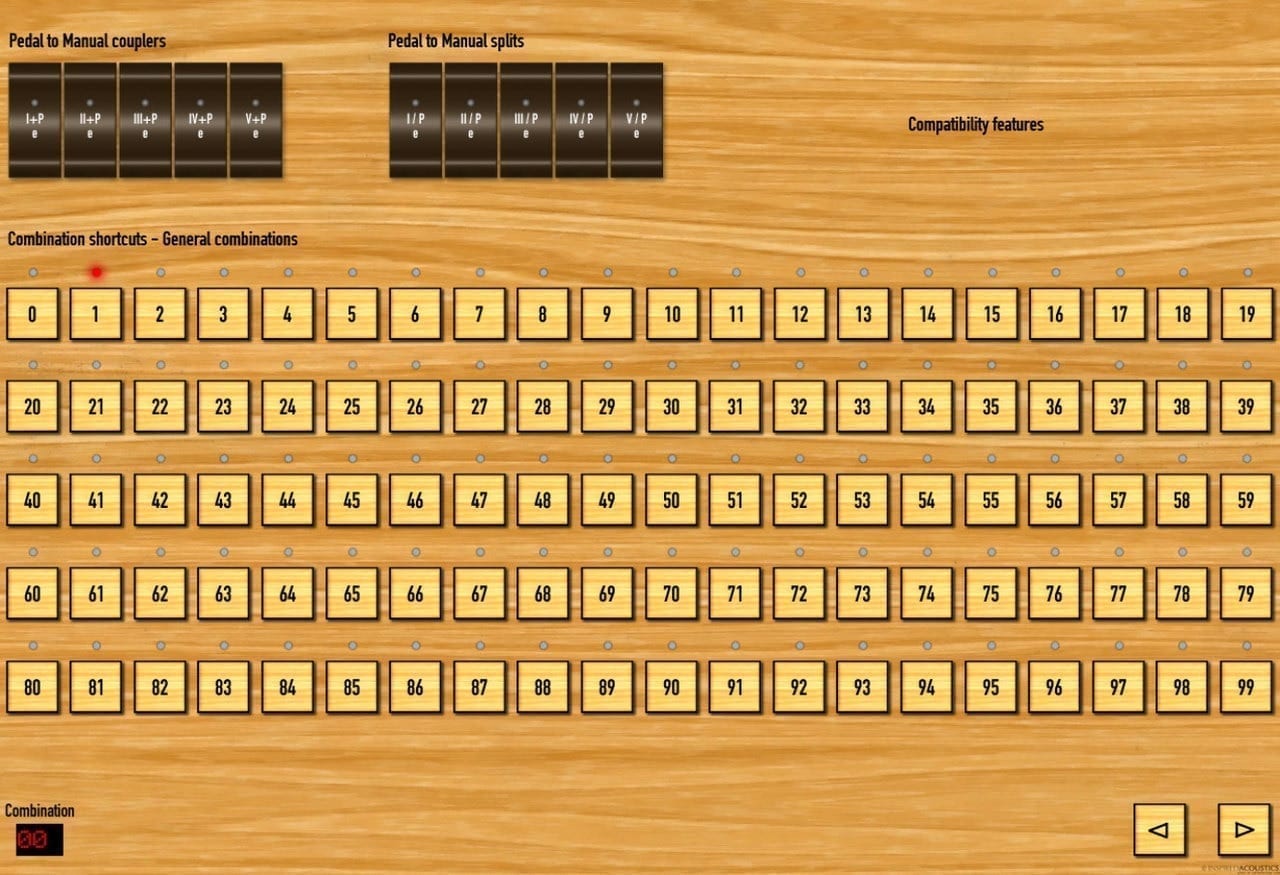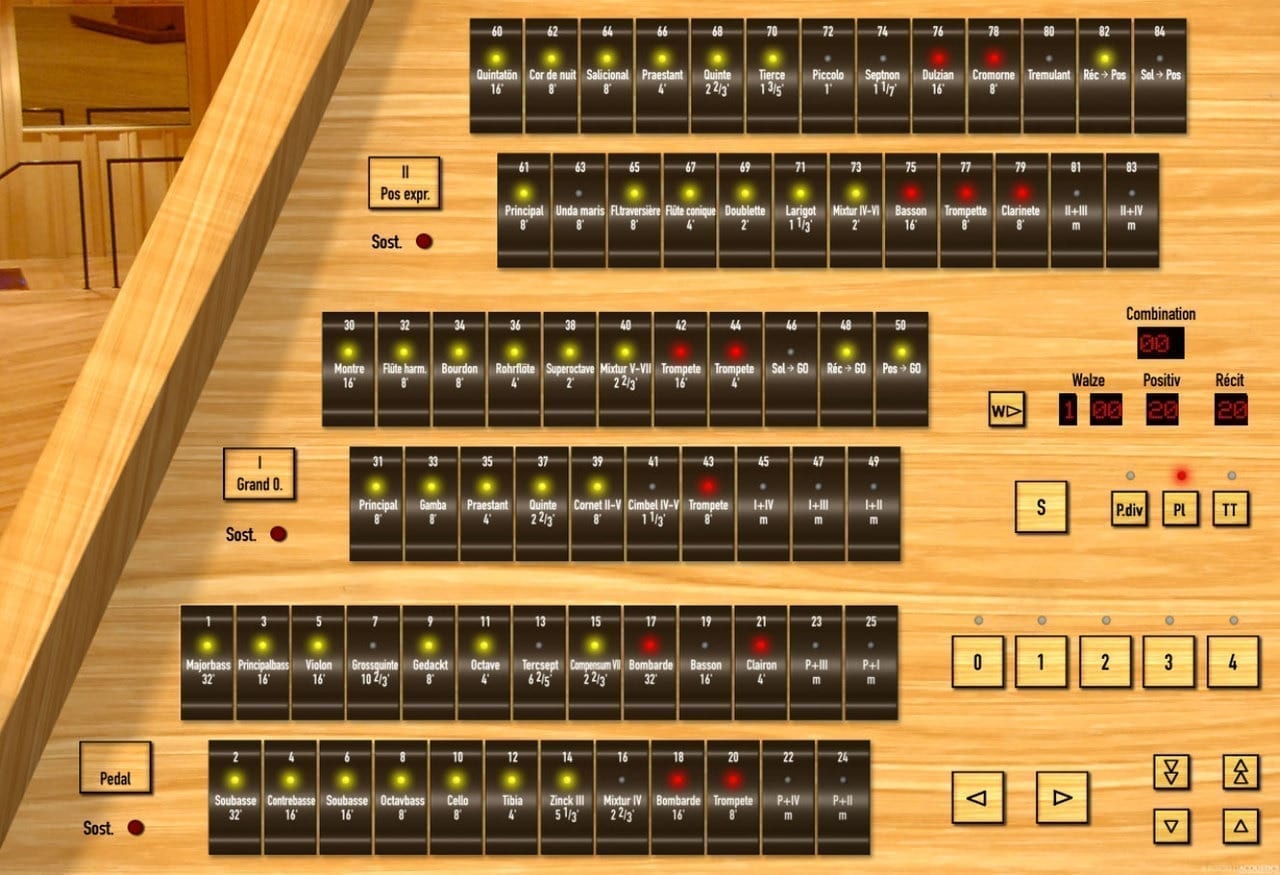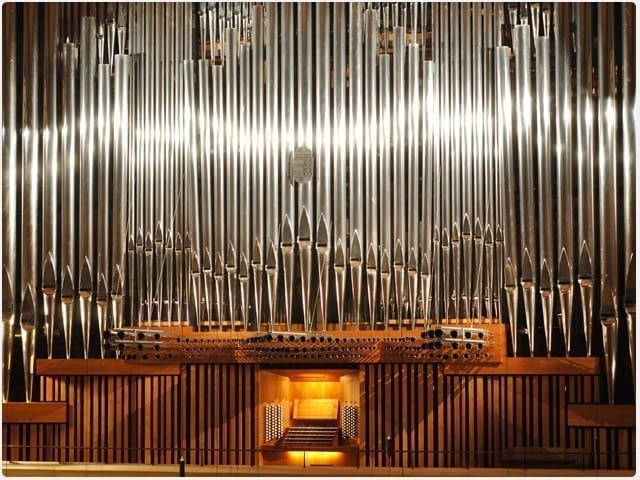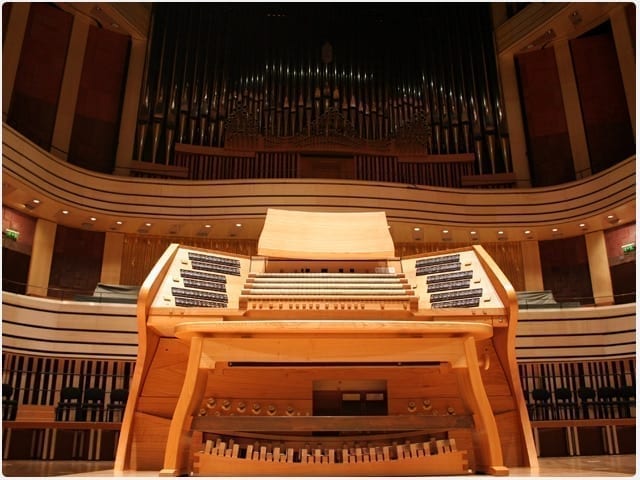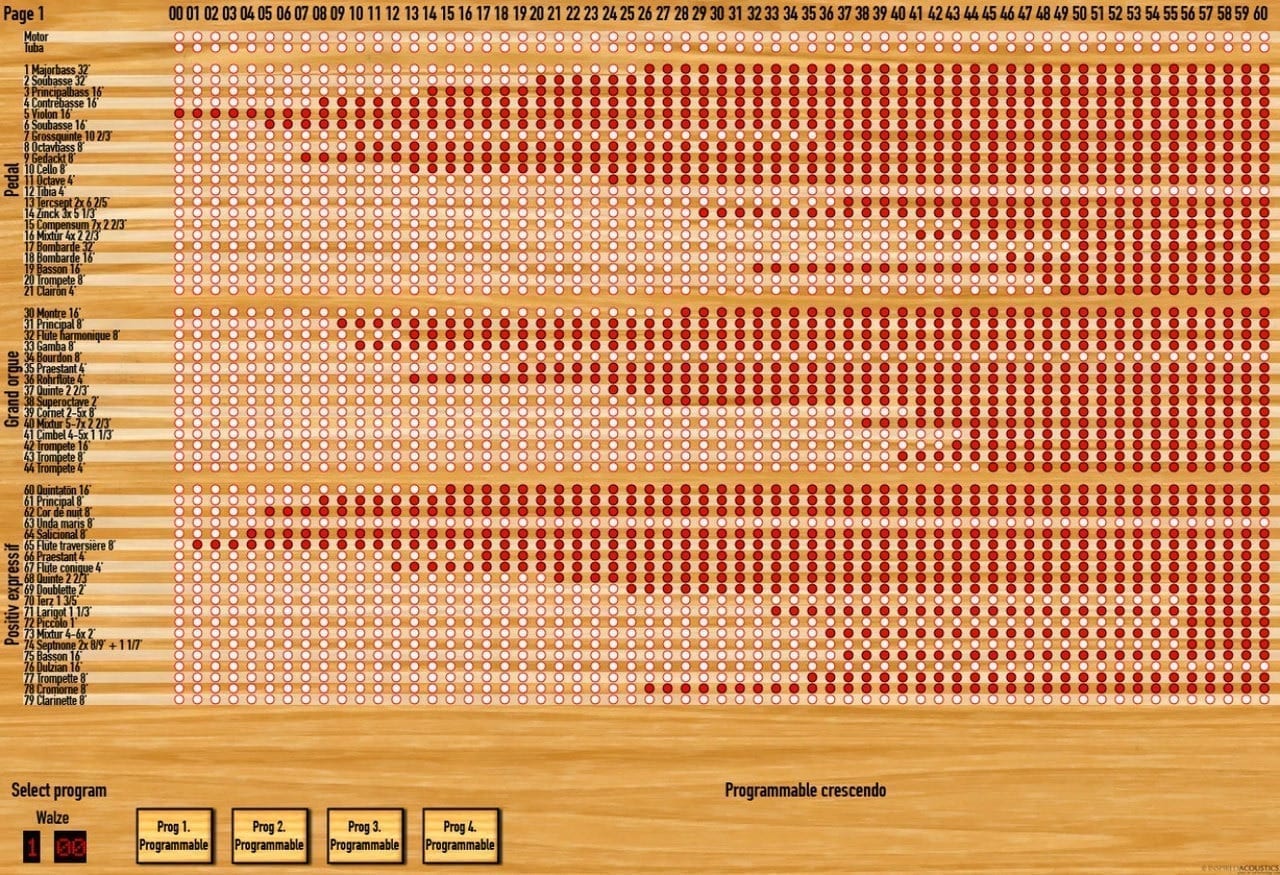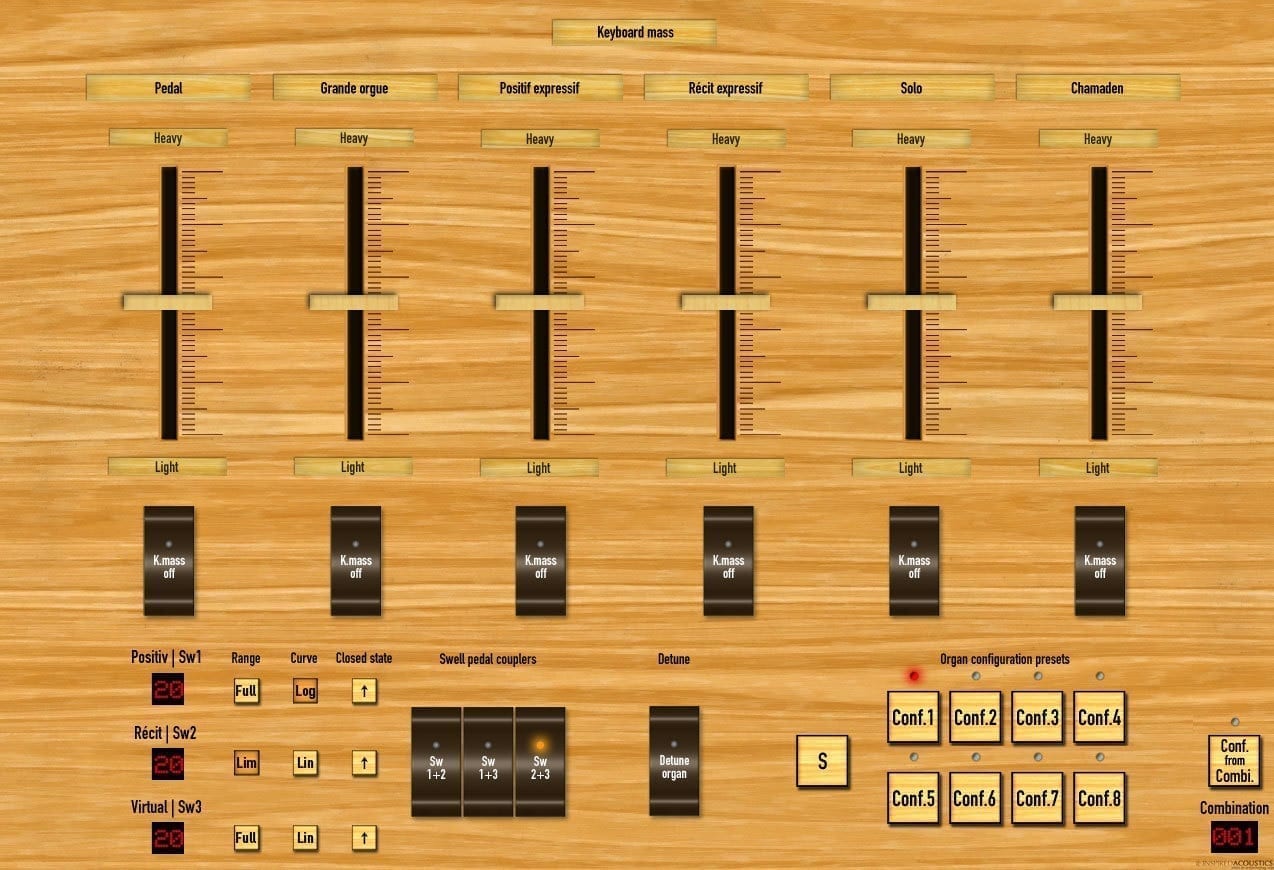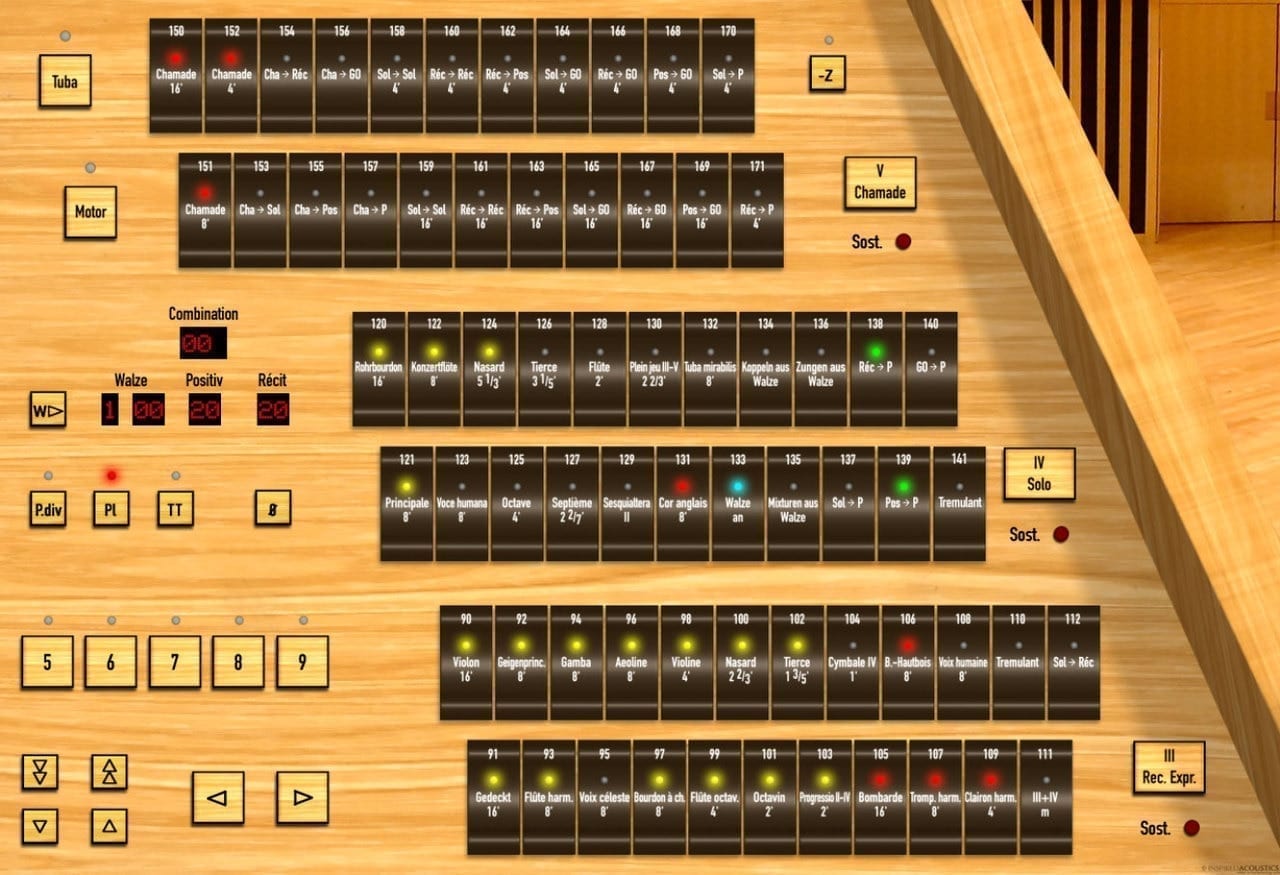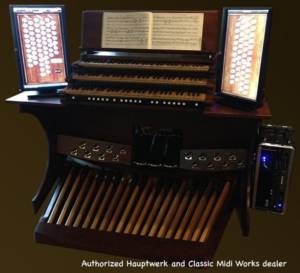Description
Palace of Arts Budapest (PAB) Pipe Organ Samples is a fully playable, freely configurable, intuitively manageable and MIDI-controllable virtual pipe organ, delivering the authentic sound of the 92-stop Pécsi-Mühleisen pipe organ of the Béla Bartók National Concert Hall of the Palace of Arts, Budapest, Hungary, to your computer.
PAB Pipe Organ Samples is published in six different editions: the Small, Essential and Medium Edition, featuring a selection of stops and features, the Professional Edition and Extended Edition with all 92 stops, and the exclusive 149-stop Gravissimo Edition with unique features plus the world’s first virtual 64′ stops. A freely downloadable Trial Edition, equivalent to the Small Edition with a time restriction is is also available. For a more detailed comparison of the Editions, please click on the Editions icon above.
*Requires Hauptwerk™ software, for both PC and Macintosh computers, Palace of Arts Budapest Pipe Organ Samples sets a new standard in virtual pipe organs used by leading organists, professional musicians, professors and tutors, educational, worship and culture institutions, recording professionals and enthusiasts.
Despite its immense size and capabilities, it is a pipe organ you can play and take with you wherever you go, offering unprecedented flexibility and sound quality never heard before in a virtual instrument
KEY FEATURES
- The real pipe organ
- the 2006 Pécsi-Mühleisen pipe organ of the Béla Bartók National Concert Hall, Palace of Arts – Budapest, Hungary; entirely virtualized
- 92 stops, 5 manuals (with 61 keys) and pedal (with 32 keys)
- 2 sweller pedals, 2 tremulants (tremolos), 61-stage programmable crescendo with different independent program slots
- 2 consoles (electrical Stage and mechanical Upper)
- Equal tuning at concert pitch (a=442 Hz)
- a symphonic organ to perform any piece of the entire pipe organ and symphonic literature without any compromise
- The recording
- High Definition Sampling (HDS) — all stops were sampled chromatically at 192 kHz / 24-bit
- Advanced Pipe Organ Measurements (APM)
- Synchronized Sampling Technology (SST)
- The sample set
- 48 kHz / 24-bit format, 2-channel stereo samples
- Natural sound image — the samples contain all spatial information as they are heard
- 12-second notes sampled, multiple loops per sample
- 2 original independent swellboxes and 2 original tremulants
- 6 swellboxes and 3 tremulants (exclusive to Gravissimo Edition)
- One-click assignable manuals, 3 swellbox pedals with adjustable range and curve (exclusive to Gravissimo Edition)
- All combination of couplers, bass and melody switches (exclusive to Gravissimo Edition)
- Extended compass for sub and super couplers, 149 virtual stops (exclusive to Gravissimo Edition)
- Optional organ engine sounds and noises
- ‘Semi-dry’ sample set with multiple release samples for providing natural concert hall reverberation and tracker action sound
- Cathedral acoustics in Medium and Extended Editions also available out-of-the-box
- Programmable crescendo wheel with enable/disable option
- Ability to disable reeds, mixtures or couplers from all Crescendo wheel programs
- Touchscreen-optimized for 4:3 displays of 1280×1024 native resolution
PAB Gravissimo is the flagship virtual instrument reproducing the sounds of the Palace of Arts Budapest pipe organ. It contains major extensions and revolutionary new features compared to the PAB Professional and Extended Editions allowing you to do more than ever before. This page contains more details about the new features and extensions.
- Additional stops and compass extensions
- 57 new virtual stops based on extensions of the originals, all together 149 stops
- Additional stops and compass extensions are separately loadable
- Divisional combinations
- 20 programmable divisional combinations for each division, all pre-programmed with a crescendo setting
- Couplers of all directions
- Mechanic couplers between keyboards
- 92 divisional electric couplers
- regular couplers between all directions
- transposing (16′ or sub, and 4′ or super) couplers
- self transposing couplers (16′ or sub, and 4′ or super) couplers
- reverse (pedal to keyboard) couplers with optional converters to split mode
- unison off coupler
- bass and melody coupler converters
- Swellboxes
- All 6 divisions virtually enclosed
- 3 freely assignable swell pedals
- Swellbox pedal couplers (one pedal follows the other)
- Swellbox range and curve adjustments
- Swellbox operational direction selector for all pedals independently
- Performance and convenience
- Keyboard to division assignment matrix
- with additional German and French keyboard-to-division preset shortcuts
- 8-preset PerformanceSequencer™ secondary combination action
- to store and recall performance-releated switches, working together or independent of PAB’s original Combination Action
- Additional controls on the right page
- Extended crescendo program and crescendo wheel that works in an additive way
- The new virtual stops are included in the crescendo program
- EasyCrescendo™ programming (one-click programming of an entire crescendo row sequence)
- Real-time dynamic KeyboardMass™ simulation and control for all keyboards
- KeyboardMass™ states can stored in the PerformanceSequencer™
- Programmable PL and TT switches that works in an additive way
- Organ aging button (detune)
- Better compatibility with Hauptwerk v4 (meaning less SysEx messages where Hauptwerk supports it)
- Still fully compatible with Hauptwerk 3
Tremulant
- 3 tremulants, with the additional tremulant for the Solo division
- Keyboard to division assignment matrix
NEW IN GRAVISSIMO VERSION 2
PAB Gravissimo version 2 is a free update to Gravissimo organists, and the new version was updated with the following content:
- Reed mixture stops: 7 new stops for the Pedal, Grand Orgue and Chamade, all together making it a 149-stop organ
- No additional RAM is needed because the reed mixture stops are shared
- Combination action compatibility with the previous version: your saved combinations will remain usable
- Divisional page and traditional programmable divisionals with couplers, preloaded with preset data, 20 for each division
- KeyboardMass™ states can now be stored in the PerformanceSequencer
- New virtual stops are now included in the crescendo program
- Better compatibility with the MIDI sequencer of Hauptwerk v4 meaning less SysEx messages where Hauptwerk supports it
- Gravissimo version 2 is compatible with Hauptwerk 3, too
ADDITIONAL STOPS AND EXTENDED COMPASS
The Gravissimo Edition features 149 stops all together, based on extensions of the original 92-stop organ. The extended stops were sound-designed using the original samples but they are unique samples.
The 57 new stops include two 64′ stops, seven 32′ stops, two chamades, two tubas and more. These additional stops play either the extended ranks or in a few cases already existing stops from a different division. The extensions can be loaded individually allowing you to configure the overall tutti sound further, even when using the super or sub couplers. All together, 75 stops extended one octave up to support super (4′) couplers and 38 one octave down to support sub (16′) couplers, 35 extended in both directions. The most important 57 additional stops have individual switches while the sound of other extended ranks are available through the sub (16′) and super (4′) couplers.
All divisions, including the pedal us enclosed in this Edition. The two originally enclosed divisions of the real organ are kept intact as the previous editions include them, while the other four are also enclosed allowing maximum flexibility. The enclosures can be assigned to the available three swell pedals. To support different organ consoles and usage types, the 3 swell pedals can also be coupled freely for a joint operation. Additionally, you can limit the operating range, set the operating curve and direction of each pedals individually. The global pedal direction selector introduced in the Extended Edition is also maintained for convenience.
The original organ of PAB features mechanic and electronic couplers. Exploiting this feature and combining this with the manual-assignment feature, all electronic couplers became divisional couplers (i.e. coupling between divisions irrespective of which manual controls them) and all mechanic couplers remained mechanical, coupling keyboards labeled with numbers. Therefore, all electric couplers are re-labeled to feature the divisional directions, providing easier use, while the mechanic couplers remained as introduced in the original organ. To complete the list of mechanic couplers, ‘IV V (m)’ was introduced to the fourth manual. Additionally, about a hundred electric couplers are introduced providing nearly all possible coupling directions, including reversed, transposing and split couplers as well as unison off. Unison off allows you with a transposing coupler used together to transpose a division one octave up or down which can be very handy for solos or improvisations, and provides an entire new layer of sounds. All non-transposing couplers (such as Pos to G.O.) and transposing self-couplers (such as Pos to Pos, 4′) have bass and melody solo switches that transform the source voice into a solo voice, either bass (lowest note) or melody (highest note).
To support organ consoles and operating environments with less than 5 manuals, an easy-to-use manual-to-division assignment feature is introduced that allows you to assign any of the five manuals to any manual divisions, even more than one division to a single manual. Furthermore with a single click you can change the order of the organ’s manuals from French to German (swapping the first and second manuals) or assign them in various other orders of your taste. These, among with the KeyboardMass™ and swell pedal characteristics can be saved in the unique PerformanceSequencer™, which allows you recalling a different organ configuration with just a single click, even during a concert. Alternatively, with a selector button, you can request PAB’s own Combination Action system to recall these features, individually for each frame. This carefully designed pioneering system provides you a flexibility and ease of use never available before. You can now decide to perform and practice pieces authentically in the keyboard order of that given era, or use one keyboard assignment for all – and manage this with a single click on the screen.
PAB Professional, Extended and Gravissimo Editions contain all stops and couplers of the 2006 Pécsi-Mühleisen organ. Its complete disposition (stoplist) is as follows:
| Pedal (C-g’) | I. Manual, Grande orgue (C-c””) | II. Manual, Positif expressif (C-c””) |
| Majorbass 32′ | Montre 16′ | Quintatön 16′ |
| Soubasse 32′ | Principal 8′ | Principal 8′ |
| Principalbass 16′ | Flute harmonique 8′ | Cor de nuit 8′ |
| Contrebasse 16′ | Gamba 8′ | Unda maris 8′ |
| Violon 16′ | Bourdon 8′ | Salicional 8′ |
| Soubasse 16′ | Praestant 4′ | Flute traversiere 8′ |
| Grossquinte 10 2/3′ | Rohrflöte 4′ | Praestant 4′ |
| Octavbass 8′ | Quinte 2 2/3′ | Flute conique 4′ |
| Gedäckt 8′ | Superoctave 2′ | Quinte 2 2/3′ |
| Cello 8′ | Cornet 2-5x 8′ | Doublette 2′ |
| Octave 4′ | Mixtur 5-7x 2 2/3′ | Terz 1 3/5′ |
| Tibia 4′ | Cimbel 4-5x 1 1/3′ | Larigot 11/3′ |
| Tercsept 2x: 6 2/5′ | Trompete 16′ | Piccolo 1′ |
| Zinck 3x: 5 1/3′ | Trompete 8′ | Mixtur 4-6x 2′ |
| Compensum 7x 2 2/3′ | Trompete 4′ | Septnon 2x 8/9′ 1 1/7′ |
| Mixtur 4x 2 2/3′ | I IV m. | Basson 16′ |
| Bombarde 32′ | I IV e. (Solo to G.O.) | Dulzian 16′ |
| Bombarde 16′ | I III m. | Trompette 8′ |
| Basson 16′ | I III e. (Réc. to G.O.) | Cromorne 8′ |
| Trompete 8′ | I II m. | Clarinette 8′ |
| Clairon 4′ | I II e. (Pos. to G.O.) | Tremulant II. |
| P IV m. | II III m. | |
| P III m. | II III e. (Réc. to Pos.) | |
| P II m. | II IV m. | |
| P I m. | II IV e. (Solo to Pos.) |
| III. Manual, Récit expressif (C-c””) | IV. Manual, Solo (C-c””) | V. Manual, Chamaden (C-c””) |
| Violon 16′ | Rohrbourdon 16′ | Chamade 16′ |
| Gedeckt 16′ | Principale 8′ | Chamade 8′ |
| Geigenprincipal 8′ | Konzertflöte 8′ | Chamade 4′ |
| Flute harmonique 8′ | Voce humana 8′ | IV V (Cham. to Solo) |
| Gamba 8′ | Nasard 5 1/3′ | III V (Cham. to Réc.) |
| Voix céleste 8′ | Octave 4′ | II V (Cham. to Pos.) |
| Aeoline 8′ | Tierce 1 3/5′ | I V (Cham. to G.O.) |
| Bourdon a cheminée 8′ | Septieme 2 2/7′ | P V (Cham. to Ped.) |
| Violine 4′ | Flute 2′ | IV IV 4′ (Solo to Solo, 4′) |
| Flute octaviante 4′ | Sesquialtera 2 2/3′ 1 3/5′ | IV IV 16′ (Solo to Solo, 16′) |
| Nasard 2 2/3′ | Plein jeu 3-5x 2 2/3′ | III III 4′ (Réc. to Réc, 4′) |
| Octavin 2′ | Cor anglais 8′ | III III 16′ (Réc. to Réc, 16′) |
| Tierce 1 3/5′ | Tuba mirabilis 8′ | II III 4′ (Réc. to Pos. 4′) |
| Progressio 2-4x 2′ | Walze | II III 16′ (Réc. to Pos. 16′) |
| Cymbale 4x 1′ | Koppeln aus Walze | I IV 4′ (Solo to G.O. 4′) |
| Bombarde 16′ | Mixturen aus Walze | I IV 16′ (Solo to G.O. 16′) |
| Basson-Hautbois 8′ | Zungen aus Walze | I III 4′ (Réc to G.O. 16′) |
| Trompette harmonique 8′ | P IV e. (Solo to Ped.) | I III 16′ (Réc. to G.O. 16′) |
| Voix humaine 8′ | P III e. (Réc. to Ped.) | I II 4′ (Pos. to G.O. 4′) |
| Clairon harmonique 4′ | P II e. (Pos. to Ped.) | I II 16′ (Pos. to G.O. 16′) |
| Tremulant III. | P I e. (G.O. to Ped.) | P IV 4′ (Solo to Ped. 4′) |
| III IV m. | P III 4′ (Réc. to Ped. 4′) | |
| III IV e. (Solo to Réc.) |
The couplers labeled with “m” and “e” are mechanic and electric couplers, respectively.
ADDITIONAL STOPS OF THE GRAVISSIMO EDITION
In addition to the original 92 stops, the Gravissimo Edition contains 57 stop switches, as listed below, making the organ a 149-stop virtual instrument. These additional stops play either extended ranks or in a few cases already existing ones from a different division. Extended ranks are made using about 1300 additional note samples, so a significant number of new notes are accessible from these stops. Some stops, such as the Chamade 32′ listed in the Chamade, Pedal and the Grande orgue divisions, are identical, and provided for flexibility and convenience.
| Pedal | Grande orgue (I) | Positif expressif (II) |
| Gravissimo 64′ | Montre 32′ | Principal 16′ |
| Principal 32′ | Principal 16′ | Unda maris 16′ |
| Violon 32′ | Bourdon 16′ | Piccolo 1/2′ |
| Mixtur IV 5 1/3′ | Praestant 8′ | Basson 32′ |
| Bombarde 64′ | Principal 1′ | Trompette 16′ |
| Basson 32′ | Trompete 32′ | Trompette 4′ |
| Trompete 16′ | Trumpet 8′ | |
| Basson 8′ | Basson 8′ | |
| Tuba mir. 16′ | Tuba mir. 16′ | |
| Tuba mir. 8′ | Tuba mir. 8′ | |
| Tuba mir. 4′ | Tuba mir. 4′ | |
| Chamade 32′ | Chamade 32′ | |
| Chamade 16′ | Chamade 16′ | |
| Chamade 8′ | Chamade 8′ | |
| Bajoncillo 8′ | Bajoncillo 8′ | |
| Chamade 4′ | Chamade 4′ | |
| Quint Bombarde 21 1/3′ | Chamade 5 1/3′ | |
| Quint Bombarde 10 2/3′ | Tuba mirabilis 5 1/3′ |
| Récit expressif (III) | Solo (IV) | Chamaden (V) |
| Violon 32′ | Principale 16′ | Chamade 32′ |
| Geigenprinc. 16′ | Principale 4′ | Bajoncillo 8′ |
| Gamba 16′ | Principal 2′ | Chamade 5 1/3′ |
| Bombarde 32′ | Flûte 1′ | |
| Tromp.harm. 16′ | Tuba mir. 16′ | |
| Hautbois 4′ | Tuba mir. 4′ | |
| (Tremulant IV) | ||
| (IV V m) |
In addition to these stops above, 98 electronic couplers are also available, coupling the divisions with straight (non-transposing), transposing or unision off couplers. Straight and transposing self-couplers have Bass and Melody solo voice functionality, pedal to manual reversed couplers have optional split functionality (when selected, the lower part of the keyboard will play the pedal voice only, useful for setups without a pedal). Note that just as in the Extended Edition, the pedal can be also split into two parts, with the lower part playing its own notes without the couplers and upper part playing the couplers only, with a freely selectable split point.

